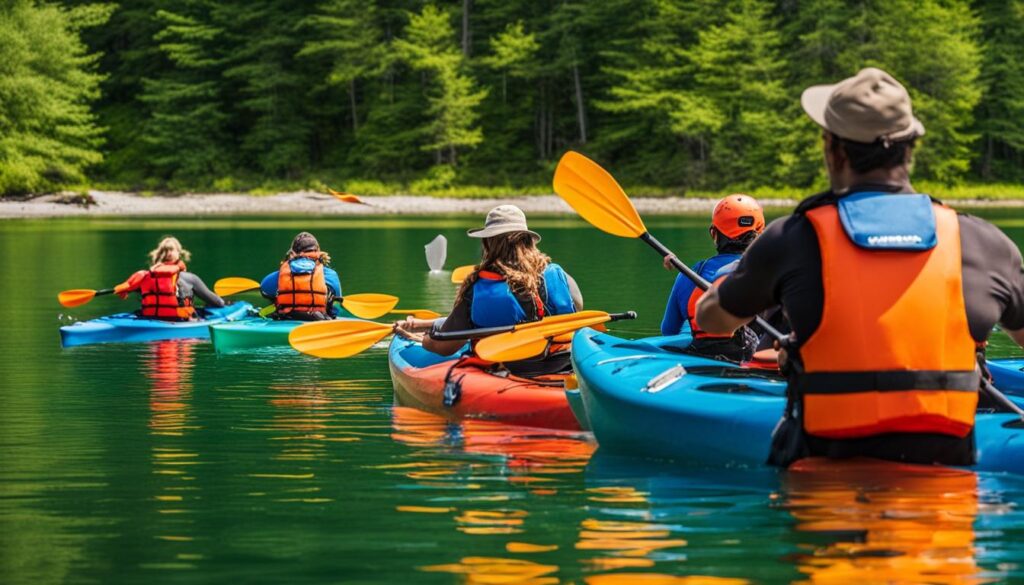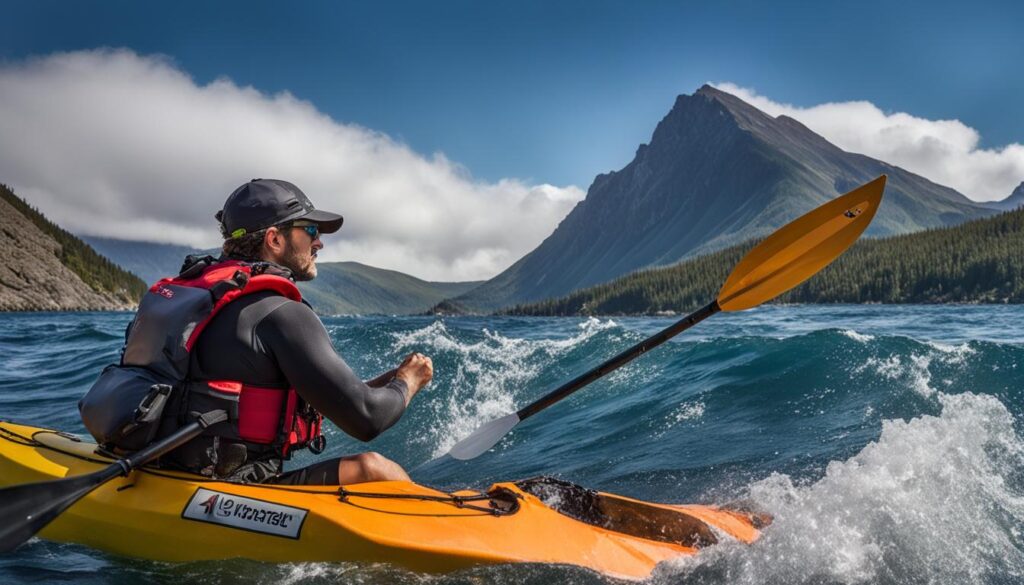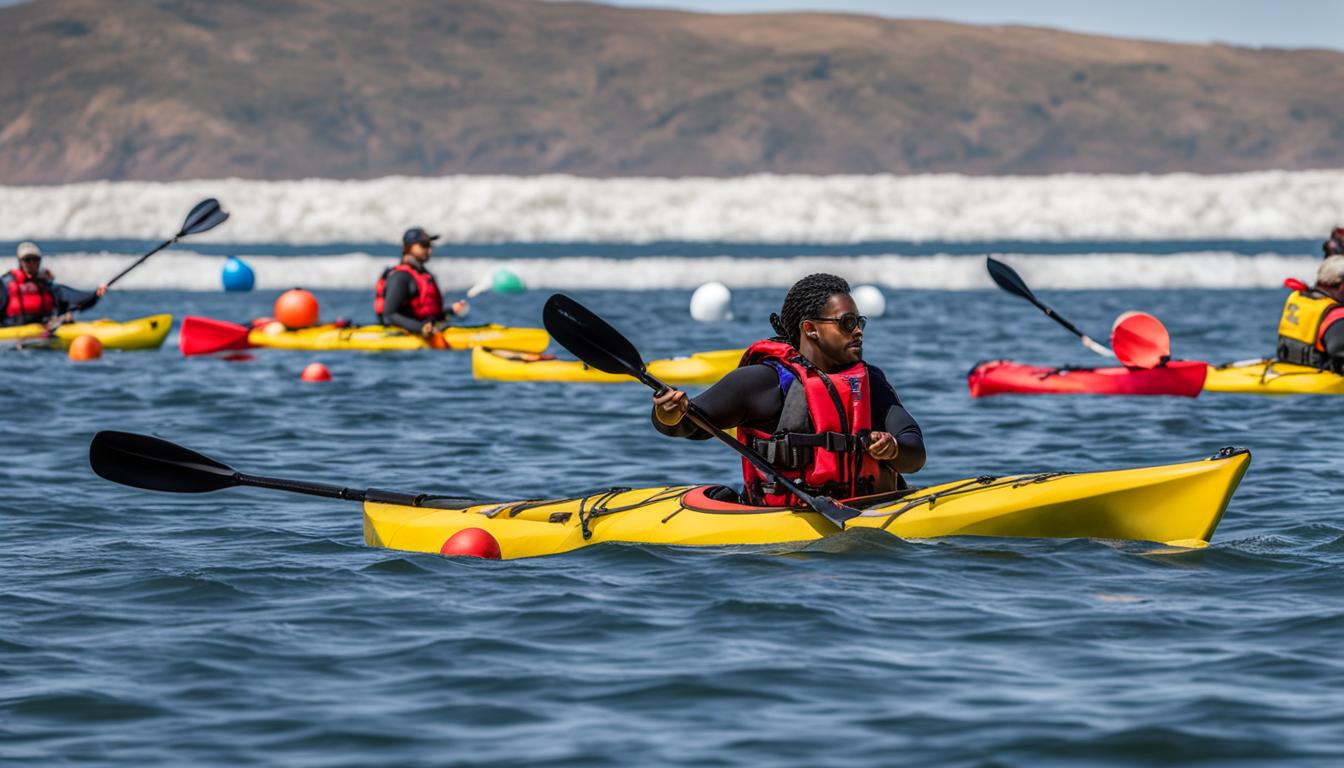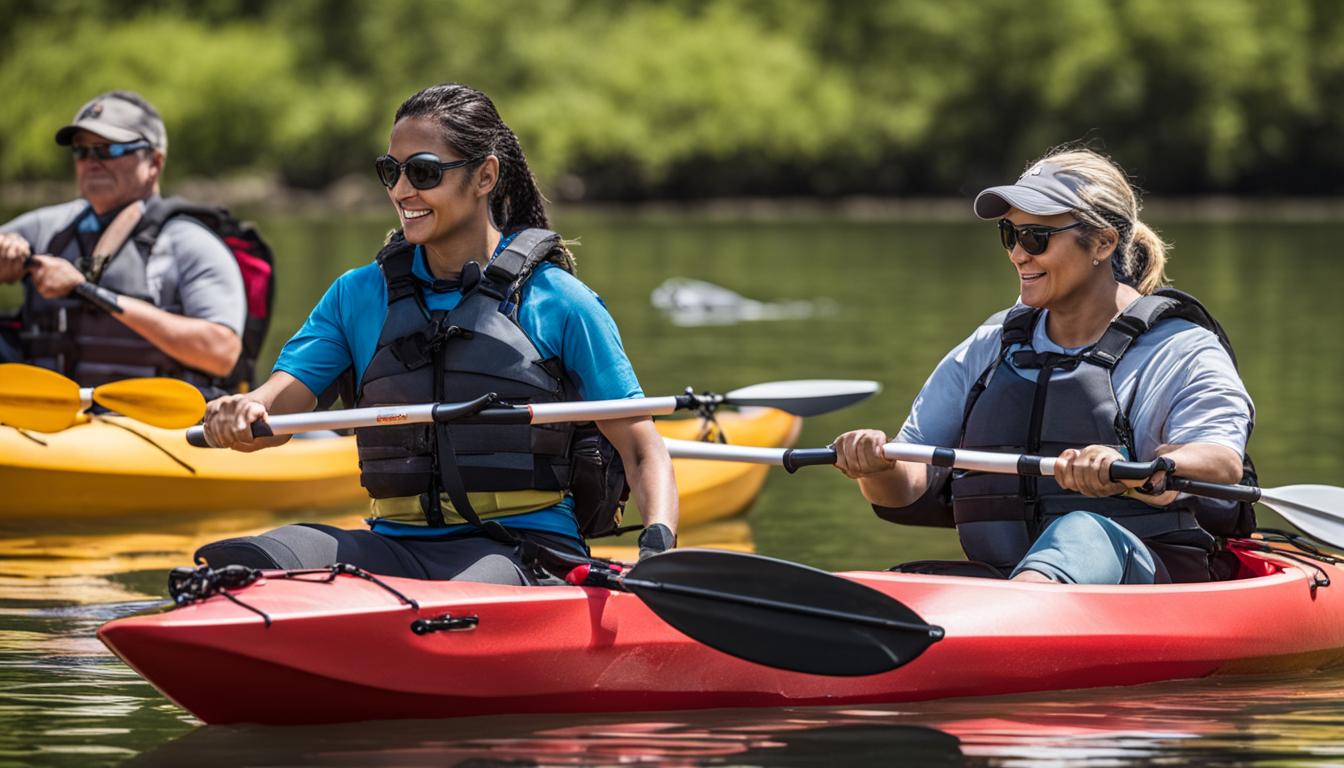Welcome to our step-by-step guide on how to become a certified kayak instructor. If you have a passion for kayaking and want to share your skills with others, obtaining kayak instructor certification is the first step towards a rewarding career in teaching and coaching. The certification process involves obtaining the necessary skills and knowledge to ensure the safety and competence of your future students.
The American Canoe Association (ACA) is a reputable organization that offers kayak instructor certification. Their certification process consists of an Instructor Development Workshop (IDW) and an Instructor Certification Exam (ICE), where you will be evaluated on various aspects of kayak instruction. Let’s dive deeper into the requirements and process for becoming a certified kayak instructor.
Key Takeaways:
- The ACA offers kayak instructor certification through an IDW and an ICE.
- Certification covers six major areas, including strokes and maneuvers, rescues and reentries, teaching and presentation skills, trip planning and navigation, on-water paddling skills, and group management and safety.
- Candidates must demonstrate competency in each of these areas to pass the certification.
- Skills and maneuvers, such as forward stroke, sweep strokes, and draws, are essential for kayak instructors.
- Rescue techniques, safety measures, and group management are critical aspects of the certification process.
Skills and Maneuvers for Kayak Instructors
As a kayak instructor, honing your skills in various maneuvers and techniques is essential to effectively teach your students. The kayak teaching certification process emphasizes the proficiency of instructors in strokes and maneuvers that are fundamental to kayaking. These include the forward stroke, sweep strokes, draw strokes, low brace, high brace, sculling brace, reverse stroke, stern rudder, and more.
To become qualified as a kayak instructor, it is necessary to possess not only the ability to perform these maneuvers fluently but also the capability to teach them effectively. The teaching process should incorporate a step-by-step progression, emphasizing key points to help students grasp and refine their technique.
There are numerous resources available to aid in the development of these skills. Instructional videos can provide valuable visual demonstrations, allowing instructors to learn and practice these maneuvers on the water. Through dedicated practice and repetition, kayak instructors can refine their skills and confidently pass on their knowledge to aspiring kayakers.
Sample Table: Basic Strokes and Maneuvers
| Stroke/Maneuver | Description |
|---|---|
| Forward Stroke | A basic stroke used for propelling the kayak forward in a straight line |
| Sweep Strokes | Used to turn the kayak by sweeping the paddle blade in an arc |
| Draw Strokes | Used to move the kayak sideways by pulling the paddle blade towards the boat |
| Low Brace | A defensive maneuver used to stabilize the kayak by placing the paddle blade horizontally on the water’s surface |
| High Brace | A defensive maneuver used to prevent capsizing by placing the paddle blade vertically on the water’s surface |
By mastering these skills and maneuvers, kayak instructors can inspire confidence and ensure their students are equipped with the necessary tools to navigate the waters safely and effectively.

Rescues and Safety for Kayak Instructors
Safety is of utmost importance for kayak instructors. As part of the kayak coaching certification process, instructors must demonstrate their proficiency in rescues and safety measures. This includes showcasing solid rough-water techniques for rescues, reentries, and rolls. Instructors should be able to perform and teach various types of recoveries such as paddlefloat rescues, T-rescues, and the use of slings. These techniques ensure that both instructors and their students can safely navigate challenging situations on the water.
Additionally, being knowledgeable about group management and safety is crucial for kayak instructors. This includes understanding how to effectively lead a group of paddlers and mitigate potential risks. Instructors must have a good understanding of water safety protocols, navigation skills, and emergency procedures. By having these skills, instructors can create a safe and enjoyable environment for their students, while also effectively managing any potential risks that may arise.
Accredited Kayak Instructor Courses
To further enhance their skills in rescue techniques and safety measures, aspiring kayak instructors are encouraged to complete accredited kayak instructor courses. These courses provide valuable knowledge and training in rescue procedures, risk assessment, and safety protocols specific to kayak instruction. By completing these courses, instructors gain a deeper understanding of best practices and industry standards, ensuring that they can confidently and effectively teach others while prioritizing safety.
Accredited kayak instructor courses typically cover topics such as water safety, teaching methodologies, group management, risk assessment, and emergency preparedness. These courses often combine both theoretical knowledge and hands-on practical experience to provide a well-rounded training program. By enrolling in these courses, individuals aspiring to become professional kayak instructors can acquire the necessary skills and qualifications to excel in their careers.
Overall, rescues and safety are essential components of kayak coaching certification. By demonstrating proficiency in rescue techniques, having a strong understanding of group management and safety, and completing accredited instructor courses, individuals can become professional kayak instructors who prioritize safety and provide high-quality instruction to their students.

Becoming a Certified Kayak Instructor
Obtaining kayak instructor certification is your gateway to an exciting career as a kayak trainer. The American Canoe Association (ACA) offers Level 1 and Level 2 Coastal Kayaking Instructor Certification Workshops for individuals like you who are passionate about teaching entry-level safety and paddling skills.
During these workshops, you’ll have the opportunity to refine your basic strokes and maneuvers, develop essential rescue techniques, expand your group management strategies, and enhance your safety knowledge. It’s a comprehensive training program that equips you with the skills and knowledge necessary to become an effective kayak instructor.
It’s important to note that certification outcomes can vary based on your performance in the Instructor Certification Exam (ICE). Depending on your proficiency, you may receive a higher or lower level certification. So, thorough exam preparation is crucial to ensure success in achieving your desired certification level.
Embarking on a career as a kayak trainer allows you to share your love for kayaking with others while making a positive impact on their lives. So, if you’re ready for a fulfilling and rewarding journey, start preparing for the kayak instructor exam and take the first step towards an exciting new career as a certified kayak instructor!
FAQ
What is the certification process to become a kayak instructor?
The certification process involves an Instructor Development Workshop (IDW) and an Instructor Certification Exam (ICE) conducted by the American Canoe Association (ACA).
What areas are evaluated in the instructor certification?
The evaluation covers strokes and maneuvers, rescues and reentries, teaching and presentation skills, trip planning and navigation, on-water paddling skills, and group management and safety on the water.
What skills and maneuvers should a kayak instructor possess?
Kayak instructors should demonstrate proficiency in various strokes and maneuvers, such as forward stroke, sweep strokes, draw strokes, low brace, high brace, sculling brace, reverse stroke, stern rudder, and more.
How can kayak instructors develop their teaching skills?
Candidates are recommended to utilize resources such as instructional videos and practice on the water to effectively teach skills using a step-by-step progression and emphasizing key points.
What is included in the evaluation of rescue techniques and safety measures?
The certification process evaluates rough-water techniques for rescues, reentries, and rolls, as well as the ability to perform and teach recoveries like paddlefloat rescues, T-rescues, and sling use.
How can candidates enhance their group management and safety skills?
Practical experience and observing experienced instructors in action can help candidates improve their group management and safety knowledge. Completing accredited kayak instructor courses is also beneficial.
What opportunities does kayak instructor certification provide?
Kayak instructor certification opens up opportunities for a rewarding career as a kayak trainer, offering Level 1 and Level 2 Coastal Kayaking Instructor Certification Workshops for teaching entry-level safety and paddling skills.
How can individuals become certified kayak instructors?
Successful completion of the certification workshops, meeting prerequisites and requirements, and performing well in the Instructor Certification Exam (ICE) leads to certification at the corresponding level.
Is certification at a specific level guaranteed?
Certification outcomes can vary, and candidates may receive a higher or lower level certification based on their performance in the Instructor Certification Exam (ICE).
Is becoming a certified kayak instructor a fulfilling career?
For those passionate about kayaking and sharing their knowledge with others, becoming a certified kayak instructor can be a fulfilling and exciting journey.





